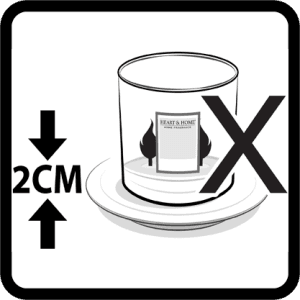
Discontinue use once the flame nears the base of the jar
We recommend that you discontinue use once the flame nears the base of the jar, around 2cm or less. This avoids the possibility of heat damage to the container or surfaces.
Light all 2 wicks to ensure candle burns evenly
To avoid an uneven burn on our 2 wick candles, It Is best to light both wicks of the ellipse candle at the same time.
Light all 4 wicks to ensure candle burns evenly
To avoid an uneven burn on our 4 wick candles, it is best to light all four wicks of the ellipse candle at the same time.
Do not extinguish a scent cup by using the lid
To put the flame out on our scent cups it’s best practice to use a candle snuffer. Do not use the scent cup lid as this would cause the lid to melt and could catch fire.
Re-centre the wick
If the wick begins to drift towards the edge of the glass snuff it out and when safe to do so, gently move the wick back to the centre and allow the wax to cool before the next burn. This will avoid the flame drifting towards the edge of the glass and causing the glass to break.
Always place a votive in a votive holder. As these candles liquify when burning
Votives must be burned in a votive holder/safe container.
Never burn a votive candle without placing in a votive holder
Votives must be placed in a specially designed votive holder
Never burn a votive candle in it’s packaging.
Under no circumstances should a votive ever be lit in it's display packaging. Always remove and place in a suitable holder or container and place on a heat resistant plate or surface.
Only use tea light in holders and wax warmers that have sufficient ventilation
Insufficient ventilation can cause the tealight to flare up.
Never use liquid to extinguish a flame
The water can cause the hot wax to splatter and might cause a glass container to break. Hot liquid wax can cause stains and severe burns.
Place candles in an upright position
Ensure candles stay upright to avoid wax dripping and to minimize the risk of flaring. Glass holders can crack if the flame touches the side.
Do not place candles near a source of heat
Do not place candles in direct sunlight or on/near a direct heat source such as a fire or radiator as this can affect the way the candle burns. Remember that electrical items like television sets also get hot and therefore should be treated as a source of heat.
Only burn candle or votive candle for a maximum of 3 hours
Candle jars must not be burned for over 3 hours per session & always trim the wick before the next burn commences. It is good practice not to burn a candle for over 3 hours at a time.
Do not move a burning candle
It is important that you do not move the candle when it is burning. The hot and liquid wax can splatter and cause tricky wax stains and perhaps severe burns.
Keep the wax pool clear of matches and other debris to avoid flaring
Flammable objects in the wax pool, such as matches, insects, flammable decorations, can ignite and cause the candle to overheat and flare up.
Always use an appropriate holder
Before lighting, place on a heat resistant plate or holder, to protect surface from any downward heat.
Always snuff out the flame. Do not blow out
It’s the safest way to prevent hot wax splatters.
Trim wick to around 5mm before lighting and between each burn
It is good practice to trim the wick back down to 5mm after each burn. This will prevent sooting on the jar.
Do not place candles in a draught
This will help prevent rapid, uneven burning, and avoid flame flare-ups and sooting. Draughts can also blow nearby lightweight items into the flame.
Do not burn candles on or near anything that can catch fire
Keep burning candles away from furniture, drapes, bedding, carpets, books, paper, flammable decorations, etc.
Always leave at least 10cm between burning candles
Especially when candles are burned on shelves, there should be a clearance distance of at least 30cm between the top of the flame and the shelf and there should be a 10cm space between candles.
Burn candle out of reach of children and pets
Never place lit candles where they can be easily knocked over anyone, especially children and pets.
Never leave a burning candle unattended
If a candle is always in full sight then any potential issues could be spotted and acted upon.


